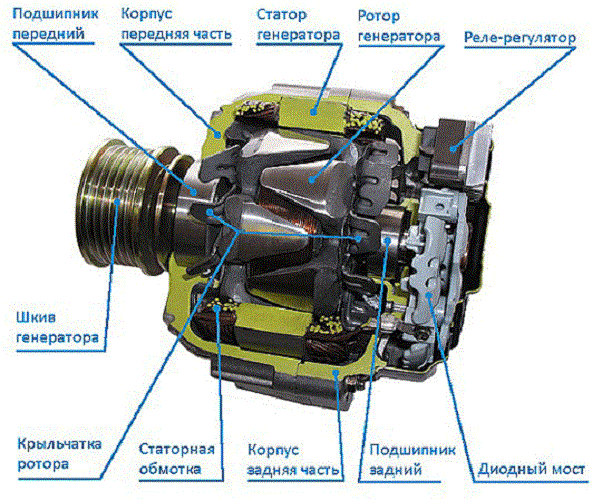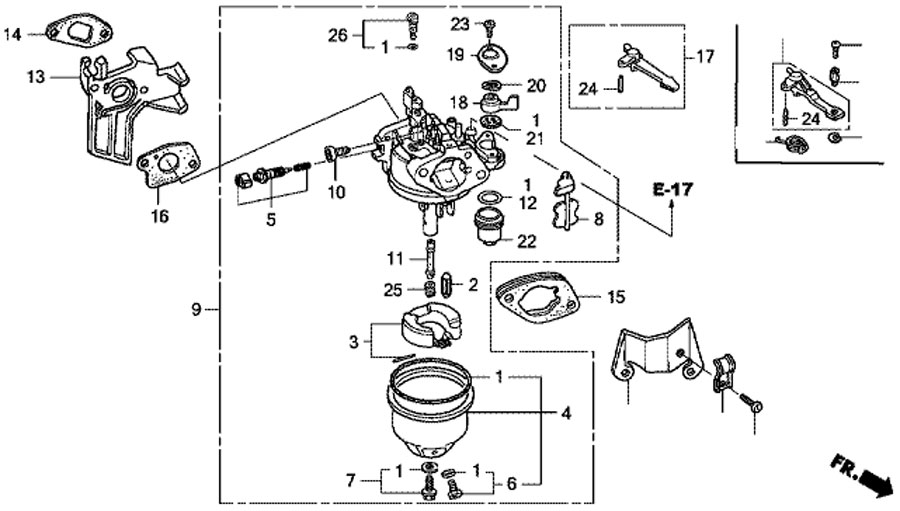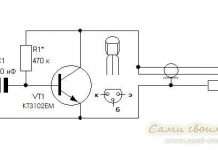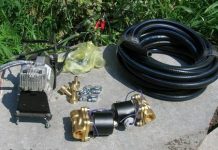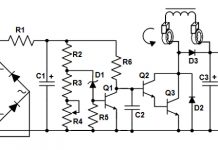In detail: do-it-yourself electric generator repair from a real master for the site my.housecope.com.
Hello dear motorists! Today I will tell you how to repair a generator with your own hands. You may have already encountered such a problem, when the battery discharge indicator suddenly came on on the dashboard, this means that your car has lost its charging, and you will not go long, the battery will last for a maximum of 1-2 hours.
Do not rush to throw away the generator. Try to repair it first. The most common generator malfunction is brush wear.
To check the brush assembly, you need to remove the rear plastic cover by bending the three plastic clips located in a circle.
Remove the cover, unscrew the two screws and remove the voltage regulator.
Check the wear of the brushes, if the residual length of the brushes is less than five millimeters, feel free to buy a new voltage regulator in the store. Sometimes it happens that the generator does not charge or recharges the battery, this is also a malfunction of the voltage regulator. The normal voltage of the generator is 13.5 to 14.5 volts, depending on the engine speed and the load on the generator.
The next generator malfunction is a breakdown of the diode bridge. To check the diodes, the diode bridge must be removed. We unscrew the bolts that hold the diode bridge.
Bend the wires to the side.
Remove the diode bridge. How to check a diode bridge. Read here: How to check a diode bridge?
After removing the diode bridge, be sure to check the stator windings. We do this, turn on the multimeter in dial mode and check all three stator windings for an open. All windings must ring among themselves.
Video (click to play).
Next, we check the short to ground. We connect one probe of the multimeter to ground, and the second is alternately connected to the terminals of the windings. There should be no short circuit to ground.
Similarly, we check the armature winding.
We check the anchor, there is no short circuit to ground.
Now I will show you how to disassemble the alternator to replace the bearings. We unscrew the four screws connecting the two halves of the generator together.
Unscrew the nut and remove the pulley.
Using a screwdriver, carefully split the generator in two so as not to damage the aluminum covers.
Replace defective bearings with new ones. Reassemble the generator in reverse order.
Friends, I wish you good luck! See you in new articles!
VIDEO
Gasoline generators, even if they are made in China, very reliable with proper care ... Nevertheless, during their operation, small problems can arise that can usually be quickly fixed with your own hands. Serious breakdowns with the knowledge of the owner of the device and the principle of operation of the generator will also not be able to disable it for a long time.
If you arrange possible malfunctions of the gas generator in a kind of rating, you get the following list:
Failure or contamination of the spark plug: difficult or impossible starting, unstable operation.
Clogged carburetor: difficult starting, excessive fuel consumption, unstable operation under constant load.
Failure of the ignition coil: no spark, inability to start.
Starter breakdowns: breakage, biting of the cable, destruction of the ratchet.
Violation of valve clearances: difficult starting, increased noise during operation.
Wear of brushes (on synchronous generators) - lack of output voltage.
Speed governor malfunction: floating engine speed, dips when changing the load.
Wear of the bearings of the crankshaft and the rotor of the generator - an increase in operating noise, oil leakage.
Wear of the cylinder, piston rings - difficult starting of a cold engine, excessive oil consumption.
It does not take into account breakdowns that result from a gross violation of the rules for operating the generator: for example, seizures on the crankshaft neck due to insufficient oil level, burnout of the generator windings or voltage converter (on inverter gas generators) with frequent overloads.
In fact, malfunctions of a gasoline generator can be divided into three groups: mechanical, electrical and fuel / ignition system malfunctions .
Difficulty starting the generator, which manifested itself suddenly and not accompanied by an increase in engine noise, is a clear sign of either deviations in the operation of the carburetor (too lean or rich mixture), or a faulty ignition system (weak or intermittent spark formation). Since the diagnostics of the state of these systems is interconnected, it is combined into one section.
Remove the spark plug and inspect the carbon deposits on the electrodes.
Dense and dry black carbon deposits - a sign of a rich mixture (the carburetor is faulty, the air filter is clogged);Oily black carbon - a sign of severe wear of the piston rings, oil enters the combustion chamber;White soot - a sign of running on a lean mixture, it is necessary to check the carburetor.Brick brown carbon deposits - normal for carburetor engines.Red, green-red carbon deposits - a consequence of working on low-quality fuel.It is simple to check the performance of the ignition system itself because of its extreme simplicity: turn on the ignition, insert a known good spark plug into the plug cap and, putting it on the nearest metal part of the engine with its skirt, turn the recoil starter abruptly. If there is no spark, disconnect the ignition switch and the oil level sensor from the ignition coil in turn: if, when both elements are disconnected, there is still no spark, replace the ignition coil.
If the spark is present and has sufficient strength (white or blue-white), remove the spark plug after several starting attempts. A candle filled with gasoline is a sign of an over-enrichment of the mixture, a dry one is a lack of fuel.
Sometimes, after long storage, the needle and the carburetor float stick and prevent gasoline from flowing inside. Several times sharply, but do not hit the float chamber lid very hard and start again.
The most common carburetor malfunction is contamination. The ingress of dirt into the air channels leads to over-enrichment of the mixture, into the fuel jets - to depletion. Dirt on the float shut-off needle leads to loss of tightness and overfilling of the float chamber, which will be immediately noticeable by the leakage of fuel from the carburetor.
Let's take a look at the carburetor maintenance on the example of a Honda GX engine - its design is typical for a gasoline generator.
Remove the float chamber cover (4). Wash it in gasoline or a carburetor spray cleaner - dirt and deposits accumulate at the bottom.
Proceed in the same way with the gas valve sump (22).
Check if the gas valve is blown in the "open" position.
Take out the float shaft (3), take out the float and the shut-off needle (2). Blow out the channel with air.
Blow out the fuel jet (25), emulsion tube (11) and all carburetor passages with an aerosol cleaner or compressed air.
Remove the adjusting screw (5), blow out its channel. Then screw it in until it stops and loosen, depending on the type of air filter, by 2 (foam, paper filters) - 2.5 turns (cyclone filters).
Assemble the carburetor.
The electrical system of gas generators is quite reliable. Most often, you can face two problems: lack of battery charging on generators with electric start or lack of voltage at the generator output .
The lack of battery charging is a consequence of the failure of the rectifier or low-voltage winding.It is easy to check this system with your own hands: connect a 12-volt light bulb in parallel with the low-voltage winding of the generator and start it. A lit light means that the generator itself is working properly, and it is necessary to replace the rectifier.
The absence of voltage at the generator output is most often the result of wear on the brushes. Remove them and assess the degree of wear, replace if necessary. If your generator is an inverter type, check if the voltage comes to the input of the converter by connecting a low-power 220 V lamp in parallel with it.
Video about the phased repair of the gas generator
VIDEO
One of the routine maintenance provided by the instruction manual for gas generators is the control and adjustment, if necessary, of the valve mechanism clearances. An increase in clearances above the norm will lead to a decrease in engine power, an increase in noise during operation. The most dangerous is a decrease in the gap, since it is not audible during operation, but the pinched valves, especially the exhaust, begin to burn rapidly. As a result, the engine starts to work unstably and, when the plate is burned out, it stops starting.
Valve Adjustment Procedure pretty simple:
Remove all components that interfere with the removal of the engine valve cover.
Remove the spark plug.
Remove the valve cover.
Set the crankshaft to top dead center of the compression stroke by the mark on the flywheel (if any) or by controlling the movement of the piston through the spark plug hole. Do not confuse compression TDC (both valves are closed ) with TDC issue (the outlet valve closes, the inlet valve opens ).
Loosen the locknuts of the adjusting screws and, using a flat feeler inserted between the rocker arm and the end of the valve, set the clearances by turning the screw. Typically, a clearance of 0.2 mm is adopted for the outlet valve, and 0.15 for the inlet valve (check in the operating instructions).
Tighten the locknuts and turn the crankshaft twice to TDC. If everything is done correctly, at the next dead center both gaps will go away, after another turn they will take the set value. Increased gaps after the first revolution are a sign that they were adjusted at TDC of the exhaust stroke.
Assemble the generator.
Manual starter malfunctions - perhaps the most common mechanical problem ... Either the cable breaks, or the starter refuses to rewind it due to a broken return spring, or the ratchet does not turn the crankshaft.
Remove the starter by unscrewing the bolts around its casing. By unscrewing the screw (1), the ratchet can be removed. Check its cams (4) and return springs (5). Then carefully remove the pulley with the spring (7). Replace a broken cable or broken spring, whichever caused the repair.
When assembling the starter, care must be taken to ensure that the spring remains in engagement with the shroud and pulley while it is being reinstalled. The cable must be fully wound around the pulley. With the ratchet in place, check the cable travel and how the starter returns to its original position.
Review and repair of the gas generator Einhell STE800
VIDEO
Sometimes it happens that the generator needs to be started urgently, and the recoil starter failed at that very moment. There are several emergency start methods if necessary.
The methods listed below unsafe !
Remove the starter cover. A flywheel with a cooling impeller is located under it, which is pulled to the crankshaft by a nut. To make it spin, you can:
With a rope wrapped around the flywheel, use it in the same way as a recoil starter rope. Note that if it snags on the fan blades, the rope will turn into a whip whip when starting the motor, so be careful. Stand so that the rope cannot get caught in your hands or head.
Low-power engines can also be started manually: with the ignition off, turn the crankshaft several times, turning the pulley by hand in the desired direction. In this case, the gas valve must be open, and the shutter of the starting device must be closed. After that, turning on the ignition, bring the crankshaft to the compression TDC (you will feel an increase in the effort on the flywheel), and then turn the pulley with a sharp jerk so that the spark energy is enough to ignite the mixture.
A powerful cordless drill and an extension head from the tool kit are a good replacement for a quick electric starter. Clamp the extension in the chuck, put a head of a suitable size on it and unscrew the crankshaft using the flywheel nut. True, in this way it will be possible to start only a low-power generator - for a large-volume engine, the drill torque is not enough to turn it on the compression stroke.
A number of faults, alas, are quite difficult to fix with your own hands, without sufficient qualifications: for example, a faulty inverter converter or voltage regulator can only be repaired with a good understanding of the principle of operation and circuitry of such devices. Not every owner of a gas generator will take up the engine bulkhead, although this is not as difficult as it might seem.
In this case, it is worth contacting a specialized repair shop. You can find out the coordinates of workshops in your city on the Internet or in shops selling gasoline-powered tools.
In large cities like many workshops , here are just a small part of them:
A car generator is a unit that is used to provide electricity to all energy consumers in a car. Failure of the generator device will lead to the fact that all equipment will be powered by the battery, and this will subsequently cause its rapid discharge. When do generators need to be repaired, and what malfunctions are typical for this device? You will find the answers below.
How much does the engine stall when the generator is loaded, what can be associated with current leakage problems, what should be the voltage, why the device does not work and how to repair the breakdown? Do-it-yourself repair of faults in automobile generators is a rather complicated matter, therefore, for a start, it recommends that you familiarize yourself with the main breakdowns of the device. Mechanical faults include damage to the mounting brackets, the unit housing, wear of the pulley and bearings, hold-down springs, etc. There can be many reasons for damage, but in any case, they have nothing to do with the electrical component.
If the car engine does not start and you think that it is the generator that has broken down, then it will be useful for you to find out about the main signs of malfunctions in the operation of the unit:
A low battery indicator appears on the dashboard when the engine is running. The light can blink or stay on without interruption.
In case of incorrect operation of the device, when a higher load is imposed on the unit than that for which it was designed, the battery comes into operation to support the power supply of the equipment. This can cause the battery electrolyte to boil off.
The next symptom is that when you turn on the headlights, you can see how the optics began to burn more dimly. If you press the gas pedal, which will lead to an increase in the speed of the power unit, then the brightness of the optics will be restored to the required level.
The device howls, hums, or whistles. If during the operation of the unit, extraneous sounds began to appear, this indicates a malfunction in its operation, which may be different. Also, the generator gets very hot.
The car engine stalls from time to time for no apparent reason. A malfunction of this kind may indicate that there is a lack of voltage in the on-board network required to power electrical equipment.If at the same time the battery is fully charged, then most likely the reason lies precisely in the generator.
Now let's consider the possible causes of malfunctions, due to which it may be necessary to remove, disassemble and repair the generator device of the car:
Pulley damage or wear. If we are talking about serious malfunctions and significant damage to the pulley, then it will be easier to replace it. In some cases, repair and refurbishment is allowed, but it is best to change the device.
Damage or natural wear of slip rings, which can be damaged.
Malfunction of the regulator. The voltage regulator is designed to equalize the operating value in the electrical network of a car, its breakdown will lead to voltage surges in the network.
Breakdown of the diode bridge of the unit. If the diodes fail, the first symptom of a breakdown is the absence or too weak spark on the candles, and the battery capacity can also be reduced.
Closing the turns of the stator winding. Sometimes the problem can be solved by rewinding the winding, but often it is easier to simply replace it.
Bearing wear. If the bearing elements are worn out and broken, additional noise will appear in the operation of the unit.
Damage to the power supply circuit.
How to disassemble and how to repair the device? Below are some basic troubleshooting tips.
These tips are relevant if you know the main causes and symptoms of breakdowns:
Sometimes self-repair of the unit is impractical, so car owners have to change the device. We will consider the replacement procedure using the example of a Lada Kalina car.
To successfully complete the replacement, prepare the following tool:
wrenches for 8, 13 and 19, for more convenience, use ring and open-end;
ratchets with heads of the same size;
extension cord with a crank (video by AndRamons channel).
The replacement procedure should be carried out taking into account the recommendations and requirements of the manufacturer, which are indicated in the service book for operation. Before proceeding with the replacement, be sure to study the manual.
So, how to remove and replace the unit yourself:
Timely repair and maintenance of the unit are the main aspects that will increase the service life of the device.
What nuances should be considered:
An illustrative lesson with a detailed description of all aspects on the principle of the unit's operation is shown in the video below (the video was published by Mikhail Nesterov).
There are two main types of generators: industrial and household. They have different power, dimensions, fuel consumption, and so on. The principle of operation is identical. The main differences are:
The household model does not have a large resource, therefore it is intended for short-term use only. Power does not exceed 2-3 kW. Produce a single-phase current of 220 V.
Industrial models are designed to run smoothly over a long period of time. The power can be incredibly high, depending on the system being served. Produce a three-phase current of 380 V.
When purchasing, the choice should be based on the conditions in which the equipment will be used. It is important to understand that a homemade gas generator is not as efficient as a manufacturer's model.
The main mechanism is a gasoline engine, the principles of a gas generator are based on it. Currently, two-stroke and four-stroke versions are used.The first type has a simple design, is lighter and cheaper, but at the same time has a minimum resource and is not intended for long-term use, although it is usually suitable for household purposes. But more often they choose four-stroke models, they fulfill their purpose in full.
VIDEO
VIDEO
The generator is the main working unit of the equipment that generates electric current. When the rotor moves, current is excited on the stationary stator, due to the alternating magnetic field. In fact, the presented aspects of physical strength and theory do not really matter. To eliminate the malfunction, it is enough to change some parts, since they cannot be repaired, but only replaced. A gas generator wiring diagram may be needed, where it will be possible to more thoroughly study the main aspects. There are differences in power:
Low-power power plants with indicators up to 2 kW. Used for short-term starting. Most often, they serve small refrigerators or to illuminate the area with several bulbs.
Medium type models with power up to 6.5 kW. The equipment is used to provide electricity to small houses, garages or shops. These are professional systems that run exclusively on gasoline engines.
Powerful electric generator up to 15 kW. Unique systems, where not only a gasoline engine, but also a diesel engine can be used, it all depends on the manufacturer. All models are only three-phase and are used to supply power to huge buildings, enterprises or industrial facilities.
Consumers have the opportunity to replace a generator or engine in any segment, but this should be done only after thinking over all further technical indicators in advance. That is, you can make one of two gas generators if some parts are damaged and unsuitable for further operation.
VIDEO
Gasoline engines are most often installed on generators, of course, there are models that run on diesel fuel, gas, but they are less popular. Various breakdowns occur during operation, and sometimes their elimination requires urgent intervention. Only in this way will it be possible to achieve the required indicator. Considering the main types of breakdowns and defects, it all comes down to the fact that they are always identical. The design of the motors is the same, and they differ only in technical characteristics, so it will be much easier to eliminate engine breakdowns than the generator. Major malfunctions:
The engine will not start. There is no fuel or spark on the spark plugs, the integrity of the crank mechanism is broken. There are defects or extraneous elements that prevent this.
Equipment operation is uneven and intermittent. The fuel has impurities, the spark plugs are malfunctioning.
Breakdowns associated with the crank mechanism. Most often this leads to the fact that there is a fuel supply, like a spark, but the engine does not start. There may be no compression due to wear on the rings.
Sometimes on Chinese models, pistons break off, as low-grade metal is used.
Poor quality oil can also clog the ducts, leading to overheating of the motor.
Carburetor clogging occurs due to poor-quality fuel, ingress of impurities or long-term non-use of equipment.
Technical issues are resolved only through specialized service stations. If there is a guarantee and service in the city, then the choice is completely obvious. In this situation, nothing can be disassembled, since specialists will refuse free repairs, due to a violation of the integrity of the structure. Therefore, you need to check the warranty period first.
The equipment has many different additional parts and mechanisms that fulfill their technical tasks. The installed inverter muffler is part of the soundproofing. When using a gas generator, a lot of noise is emitted, so it must be minimized. Developers are trying with all their might to create more advanced systems of these devices.
Regarding the presented aspect of the repair work, it is recommended to contact specialized service stations. You can buy a new generator for a gas generator and install it yourself, otherwise you cannot do without the help of specialists. The main types of breakdowns and methods of elimination:
The generator does not produce electricity or is intermittent. Violation of the integrity of the electrical circuit, the winding is damaged, the motor does not transmit torque.
A burning smell appeared. The generator has burned out, a short circuit has occurred.
For any type of violation, it is recommended to stop the engine immediately. Further, an external examination is carried out or a master is called. The second option will be more rational and efficient.
A starter is required to start the engine. Most often, manual is used, but more powerful models are equipped with electric starters similar to automobile ones. Repair and maintenance of these technical elements is carried out by complete replacement. The problem is that most of them are not repairable. Routine disassembly can lead to the fact that you simply cannot put everything back.
The main condition for carrying out repair work is to refer primarily to the technical manuals. This will allow you to deal with all breakdowns and other restrictions in advance. Your hand will be the ultimate guide for repair and maintenance. Electronic components are checked using specialized stands. That is, it is computer software that will allow you to identify all the flaws in the equipment at an early stage.
Regardless of the type or brand, all gasoline generators are serviced in the same way. For the convenience of consumers, special manuals and recommendations are attached to the equipment so as not to forget about the planned maintenance. You must always start with an external examination, so as not to miss damage to external parts. Of course, if you have a Chinese inverter generator, you may have problems finding components. The main types of work included in TO:
The inspection should consist of viewing all work items.
It is necessary to remove the air, fuel filter and replace it with a new one. The duration of the shift depends on the duration and frequency of use of the equipment.
It is recommended to replace belts, candles.
A standard stand-alone generator requires regular oil changes.
Based on the aspects presented, it will be possible to increase the service life of the equipment to the maximum.
You can replace a wheel with mobile equipment without any particular problems.
It is recommended to pay attention to the Fubag technique, this is a German brand that produces new generation electric generators. This option will be able to fully satisfy all the individual wishes of customers. The company produces various types of equipment models with different technical characteristics. That is why you can easily pick up everything you need without any restrictions.
Of course, in order to properly carry out maintenance and repairs, you need to know the device of the gas generator, then you can not only change the parts, but also put it back together. This is not so easy to do, since there are a large number of different nuances that are recommended to be studied at the preliminary stage.
Any equipment requires professional care. Therefore, it is recommended to adhere to the rules that the manufacturer provides to customers. These are very important aspects that will not only improve the start-up of equipment, but also increase the turnaround time. Key recommendations:
For long-term storage, it is imperative to drain all fuel from the tank. Gasoline oxidizes carburetor parts, which can clog the passages.
It is recommended to use polyethylene to cover the equipment during long-term storage to protect it from corrosion and moisture ingress.
It is best to carry out maintenance before storage.
In no case should the generator be left disassembled for a long time, as foreign elements can get inside.
Store in a cool, dry place.
Do not start up equipment in severe frost if it is not designed for use in such conditions.
Thus, you can protect not only your money, but also your equipment. Currently, manufacturing companies provide customers with special technical instructions that go into all the details in detail.
VIDEO
VIDEO
A car generator is a device that takes mechanical energy from an engine and converts it into electric current, thus providing electricity to the rest of the car's units. The generator provides battery charging and power to the vehicle's engine. Therefore, the connection "engine-generator" should not be interrupted, because an inoperative generator is a battery that does not receive a charge and, accordingly, an inoperative main body of the car.
So the generator is broken. What malfunctions can cause this device to malfunction? Let's consider them:
The generator produces a very low voltage current.
The generator does not generate electricity at all.
A breakdown of the device is displayed on the dashboard in the form of a blinking light.
The generator is charging in excess of the optimal rate.
Generator operation is accompanied by extraneous noise.
Before you start doing generator repairs with your own hands, it is necessary to check its technical condition and disassemble the unit into parts. Before disassembling the generator, check the condition of the belt and its tension and make sure if you are expecting a replacement of the alternator belt in the near future (read also how the timing belt is replaced with a VAZ 2109). Checking consists in pressing your finger on the middle of this part of the generator. If the belt is in good condition, then it should not fall by more than half a centimeter when pressed. It should be noted that the new belt should not bend more than 2 mm. If the belt is not worn out, but the tension is weak, then the defect can be corrected by tightening the generator belt. Also scroll the generator tension roller, if it scrolls with difficulty and squeaks, then it will need to be oiled, or put a new roller instead.
The technical condition of the generator can be checked using the following measuring instruments:
The rotor speed is measured using a tachometer (usually located next to the speedometer on the dashboard).During normal operation of the generator, the indicators of this device should not be less than 2000 rpm, while the norm is 5000 rpm.
Let's consider the reasons that can cause generator breakdown. So, if the generator does not generate a charge, then the following phenomena may be the reasons for this:
Fuse or contacts blown.
Broken or worn out generator brushes.
The regulator relay is out of order.
Due to the short circuit of the winding, an open circuit occurred in the stator or rotor circuit.
In order to fix the first three malfunctions from the list, you just need to replace the worn out parts of the generator, having previously, of course, disassembled it.
First of all, remove the brush holder along with the voltage regulator, carefully unscrewing all fasteners.
Remove the tensioning bolts and then the cover with the stator.
Remove the cover from the stator by first disconnecting the phase windings from the output wires on the rectifier unit.
Next, remove the pulley from the shaft and the front cover of the generator using a special puller.
The assembly of the generator is carried out in reverse order.
In the event of a short circuit in the winding, you will need more serious action than a simple replacement of the part. So, a broken winding can either be repaired or replaced with new wires. Often the winding breaks off near the slip rings. In addition, breakdown can occur due to unsoldering of any of the ends of the winding. Such a malfunction can be repaired by rewinding the coil in the area of the gap back from the rotor winding. Further, the broken end of the winding must be removed (evaporated) from the slip ring and the previously unwound wire must be soldered there. The wiring is very easy to repair by re-soldering the wiring.
A weak or too strong generator charge is indicated by a damaged relay, which must be replaced when the generator is repaired.
If the generator voltage check showed that the device is working, but the indicator is flashing on the instrument panel, then, most likely, one of the diodes that are responsible for powering the light in the indicator has failed. These diodes are located in the generator itself, and replacement is carried out after disassembling the device.
Noise unusual for a generator may be indicated by wear of the rotor bearing. If an inspection reveals that the generator bearing is worn out, it will need to be replaced. If the incomprehensible sounds of the generator are associated with the absence of play in the bearing, then it can be simply filled with oil, having previously washed it in gasoline. Extraneous sounds will then disappear.
Thus, you can even repair the generator on your own in your garage (as well as overhaul of the engine, in fact). When checking and replacing parts of the device, observe safety precautions and be careful, because the electrical system should not be damaged in this case.
Video (click to play).
VIDEO

